You are using an out of date browser. It may not display this or other websites correctly.
You should upgrade or use an alternative browser.
You should upgrade or use an alternative browser.
Wadkin PK restoration
- Thread starter wallace
- Start date

Help Support UKworkshop.co.uk:
This site may earn a commission from merchant affiliate
links, including eBay, Amazon, and others.
The area of the pattern is somewhat thin. So I am thinking this is due to rapid cooling. If it was a cold day and the first pour of the day along with the thin section, it may likely be due to rapid cooling.
In that time frame, Wadkin may also have been using a cupola coke furnace. So the first tap of the morning may have been cooler than normal.....
Love the knowledge, learn new things I didn't know I didn't know every day on here!
Edit: not to leave them out, also glued to every Wallace, Deema, Sideways, T French, etc thread.
Last edited:
TheTiddles
Established Member
Rapid cooling causes lots of small crystals, slow cooling favours formation of larger crystals. If those are crystal boundaries, they are big, so slow cooling.
If I was looking down a microscope at it, I’d be sure what it is, just never seen that pattern at that size
If I was looking down a microscope at it, I’d be sure what it is, just never seen that pattern at that size
Devmeister
Established Member
Rapid cooling causes lots of small crystals, slow cooling favours formation of larger crystals. If those are crystal boundaries, they are big, so slow cooling.
If I was looking down a microscope at it, I’d be sure what it is, just never seen that pattern at that size
What would cause slow cooling in a sand mold? How would this influence the part?
Very much enjoying this Wallace. Thanks for sharing it with us.

I use both acetone and isopropyl alcohol regularly as workshop solvents and have no problems buying either mail order from the many suppliers on ebay. In 5 litre plastic containers they are not too expensive.
70% IPA (no, not India Pale Ale) : 30% water I believe constitutes rubbing alcohol which is super versatile and cleans spectacles, safety visors, and all sorts.
I use both acetone and isopropyl alcohol regularly as workshop solvents and have no problems buying either mail order from the many suppliers on ebay. In 5 litre plastic containers they are not too expensive.
70% IPA (no, not India Pale Ale) : 30% water I believe constitutes rubbing alcohol which is super versatile and cleans spectacles, safety visors, and all sorts.
Devmeister
Established Member
Really!!!!!!Very much enjoying this Wallace. Thanks for sharing it with us.
I use both acetone and isopropyl alcohol regularly as workshop solvents and have no problems buying either mail order from the many suppliers on ebay. In 5 litre plastic containers they are not too expensive.
70% IPA (no, not India Pale Ale) : 30% water I believe constitutes rubbing alcohol which is super versatile and cleans spectacles, safety visors, and all sorts.
Our government has decided acetone is to dangerous. So it’s a struggle for us. But due to labeling and license issues we can buy it as auto finish reducer yin 5 gal cans.

£400.66
Trend Portable Benchtop Router Table with Robust Construction for Workshop & Site Use, 240V, CRT/MK3
Qwikfast Trade & DIY Supplies Limited

£96.56
£101.95
O'SKOOL Mortise and Tenon Jig is Ideal for cabinets, Chairs, and Table Construction Using a Plunge Router
Amazon US

£12.50 (£1.25 / count)
£14.45 (£1.44 / count)
JSP M632 FFP3moulded Disposable Dustmask (Box of 10) One Size suitable for Construction, DIY, Industrial, Sanding, dust protection 99 Percent particle filtration Conforms and Complies to EN 149
Amazon.co.uk

£17.99 (£1.80 / count)
£27.44 (£2.74 / count)
3M 8822 Disposable-fine dust mask FFP2 (10-pack)
Amazon.co.uk
TheTiddles
Established Member
Sand! It’s a rubbish conductor and cooling a thick part quickly is hard… though fast and slow is all relative, what you also want is even cooling so all the part shrinks at the same rate and that’s as much to do with the material around the part as it is with the design of the part itself, the material that goes in it, the process before and after etc… Slow cooling gives more time for crystals to grow, so they’re larger. Small crystals makes for a tougher material as a crack has to deviate further around the grains or has to initiate a crack through more grains to propagate (depending if it cracks through the grains or around them)What would cause slow cooling in a sand mold? How would this influence the part?
Old castings are generally not very good and they had to use huge sections to get a usable part out, cutting off piles to get it flat and then there’s inclusions and bubbles in it as well as being chunky, it cooled slowly. Now the entire process can be modelled and optimised, the properties of the material finely adjusted in the molten state, it’s all very impressive.
Last edited:
Devmeister
Established Member
I have seen the software for estimating cooling and it’s impressive but…..
I have been casting metal since 1976 and have made my share of patterns and yes, I use shrink rules. But often I have to replacement parts for vintage machine tools and steam engines. The castings on the coffin nose Stanley’s are some of the roughest castings I have come across.
I just finished the patterns for a replacement fence on an Oliver 287 shaper. While accurate there are issues. The main webbing is relatively thin compared to the lead screw bosses. I cored these not because it makes machining easier but rather gives me more control over non linear cooling. Clearly the gates need to be adjusted and the use of a riser to feed the casting will be needed.
pattern making was an art. And having been thru the naked details of my PK I have to say I am quite impressed at the pattern work done by Wadkin. Oliver was also quite impressive with theirs. Remember Wadkin was impressed at rolls Royce pattern makers and was primarily a supplier to the pattern industry.
Wallace had done many wadkins and I have three. I hope to begin my RU and LQ shortly. This feature is one we have not seen before. In my pours, I have not seen it either. I use old brake rotors for casting stock and use diesel fuel for heat.
The more I study design and machine work, the more impressed I am with the PK. Damm those blokes at green lane truly had their stuff together!
As curved as the body is, it’s cross section is bloody consistent and even. The casting defects are usually limited to minor sand pulls and sand falls.
So while your argument makes sense I have to question it. As someone who casts iron it’s something that greatly interests me. Of all the PKs we have worked on spanning three continents, why have we not seen this before?
oliver used semi steel and many US machine guys were hooked up with meehanite after the 1940s. The steam engine work for cars and smaller stationary engines all dated back from the late 1800 s forward to the 1920s.
I have also dabbled in casting 8620 gun parts using lost wax. It’s a push as you need to get to 2800 degrees just to have a chance!
so I am really curious about this.
I have been casting metal since 1976 and have made my share of patterns and yes, I use shrink rules. But often I have to replacement parts for vintage machine tools and steam engines. The castings on the coffin nose Stanley’s are some of the roughest castings I have come across.
I just finished the patterns for a replacement fence on an Oliver 287 shaper. While accurate there are issues. The main webbing is relatively thin compared to the lead screw bosses. I cored these not because it makes machining easier but rather gives me more control over non linear cooling. Clearly the gates need to be adjusted and the use of a riser to feed the casting will be needed.
pattern making was an art. And having been thru the naked details of my PK I have to say I am quite impressed at the pattern work done by Wadkin. Oliver was also quite impressive with theirs. Remember Wadkin was impressed at rolls Royce pattern makers and was primarily a supplier to the pattern industry.
Wallace had done many wadkins and I have three. I hope to begin my RU and LQ shortly. This feature is one we have not seen before. In my pours, I have not seen it either. I use old brake rotors for casting stock and use diesel fuel for heat.
The more I study design and machine work, the more impressed I am with the PK. Damm those blokes at green lane truly had their stuff together!
As curved as the body is, it’s cross section is bloody consistent and even. The casting defects are usually limited to minor sand pulls and sand falls.
So while your argument makes sense I have to question it. As someone who casts iron it’s something that greatly interests me. Of all the PKs we have worked on spanning three continents, why have we not seen this before?
oliver used semi steel and many US machine guys were hooked up with meehanite after the 1940s. The steam engine work for cars and smaller stationary engines all dated back from the late 1800 s forward to the 1920s.
I have also dabbled in casting 8620 gun parts using lost wax. It’s a push as you need to get to 2800 degrees just to have a chance!
so I am really curious about this.
TheTiddles
Established Member
Yep, I’m curious too! If it was a few mm across it’d be obvious grain boundary, but on that scale?
I like old castings for aesthetic purposes, but if I got one of the quality they are at work I’d probably never speak to that supplier again.
I like old castings for aesthetic purposes, but if I got one of the quality they are at work I’d probably never speak to that supplier again.
wallace
Established Member
I have seen alot of wadkin castings and not come across this before. The same affect is on the other side as well.
Devmeister
Established Member
Casting Iron is Casting IronYep, I’m curious too! If it was a few mm across it’d be obvious grain boundary, but on that scale?
I like old castings for aesthetic purposes, but if I got one of the quality they are at work I’d probably never speak to that supplier again.
1). Today we have furin resins and other refractory products. Industrial scale lost foam and lost wax has really evolved. To improve surface finish, the old timers used coal dust. Today we have a pink refractory spray. When doing something latgr And one off, I will use water glass on the whole mold. But your still often fighting surface finish which is affected by grain size of sand if you don’t use a surface prep refractory. Pettrobond helps and is a pleasure to work with compared to green sand but OMG it doesn’t do well with Iron. Will set off every smoke detector in the block.
2). Modern castings are better than old ones….. you my freind have not lived the Cummins 53 block fiasco! The castings were cosmetically better than old castings but the pattern cores were inconsistent and shifted on some blocks. My newer block was Mexican and a real piece of artwork. Excellent surface finish, minimum flash esp in the journal bay and really consistent patterns. The surface finish screamed out furin refractory spray!
The castings I have seen on Bridgeport’s are very good but not perfect. Hoffmann out of Germany has killer castings but a lot of fettling prior to finish.
Csstings used by caterpillar and John deer are in a total different realm with many being welded which tells me they are steel.
when I melt brake rotors I am melting ductile iron but that doesn’t mean anything. At temperature you loose your grain structure and your innoculents. What does not put gas often winds up in the drose or slag.
so you have to add your special recipe to the crucible just prior to pour. The main ingredient is ferro- silicone which assists in solidification nuclei. There are a couple of foundary specific innoculents that I am expermitting with. One to get consistent class 60 cast iron and the other to explore the possibility of going to a modular or ductile iron.
One issue is oxygen. Useing any form of fossil fuel wheathet its diesel or coke can burn off carbon from the melt. Use of fluxes help but you don’t have the precise control of carbon like you have in induction heating.
If your using semi steel like Oliver did, this is worse. How much virgin pig iron do you use with brake rotors and how much steel scrap?
At the end of the day a casting is a casting…. No banking surfaces! So you need to initially machine in your banking surfaces from which every other feature is based. No matter how sexy your casting, I don’t trust anything. I do trust my DROs and indicators on a machined surface.
TheTiddles
Established Member
I think we work at different ends of an industry and most definitely different centuries.
Devmeister
Established Member
Now you have tipped my courtesy. The older green generals were known for fit and finish… it helped that family who owned general also owned the foundary that cast meehanite parts for US automakers.
Hoffman in Germany makes the finest wood shapers sold new today. The family also owns a foundary.
The Chinese machine tools imported into the US are junk. Even flashing is just painted over.
The biggest issue with sawstop is the SOFT iron used in the saws and warpage of tops over time.
Companies like Bell Gosset updated pump models by going to injection or die cast aluminum parts which require less precision machine work.
Lie Nielsen had nice castings and they done by Enterprise Foundary in New England. Aside from using an induction furnace they still use sand casting along with mold squeezer line machines.
The foundary industry in the US has been decimated. Powematic used to have their own and they had meehanite certification.
What examples of modern castings can you provide that can give us an example of state of the art? If there are tidbits that can help us out in our struggles to produce better castings, it would be a great help to this small community.
Hoffman in Germany makes the finest wood shapers sold new today. The family also owns a foundary.
The Chinese machine tools imported into the US are junk. Even flashing is just painted over.
The biggest issue with sawstop is the SOFT iron used in the saws and warpage of tops over time.
Companies like Bell Gosset updated pump models by going to injection or die cast aluminum parts which require less precision machine work.
Lie Nielsen had nice castings and they done by Enterprise Foundary in New England. Aside from using an induction furnace they still use sand casting along with mold squeezer line machines.
The foundary industry in the US has been decimated. Powematic used to have their own and they had meehanite certification.
What examples of modern castings can you provide that can give us an example of state of the art? If there are tidbits that can help us out in our struggles to produce better castings, it would be a great help to this small community.
Devmeister
Established Member
A beginners guide to casting would be really appreciated, its something I’d like to have a go at at some point. I’ve watched a lot of uTube stuff, but you never know too much!
My first run in 1976 was to melt down pop cans for basic items using pettrobond sand. It was in my high school shop class. I learned a lot. Alloys like brass and some bronzes are a pain. Zinc which is used in some of these alloys will boil off at temperature. That creates two issues. It changes the alloy as nd exposes you to fumes that are bad. The aliment known as “foundary shakes” is not pleasant. It’s actually painful as it’s like epilepsy. I kept telling the ER doc I need cold milk and lots of it. Later I educated the doc about this old foundary cure as he had never seen this before nor did he have any exposure to it in Med school.
Alloys like English gun metal have been lost. The closet I have found is a 4 series naval brass.
Pouring iron is not for the faint of heart. 40 to 100 pounds of white hot iron will get your attention and iron pours like water. If there are any bits of moisture, the stuff explodes sending white sparks everywhere.
I saw a report of an accident in China where a multi ton pouring ladle failed and sent tons of white hot iron everywhere.
Most commercial foundries will not touch a one off. They require match plates and need to know how many hundred or more parts per month you need.
so we have a few venues to get around this and it’s a struggle.
If you look at how Lodge does their cast iron pots and pans you can get an idea of how some of the commercial guys do it.
what would be nice is see the results of what is achievable with the latest trends and innovations.
TheTiddles
Established Member
By modern, I think more like this…
Though that’s not cast iron, but this is…
Not nearly as exciting as the old ways and it’s crushingly disappointing the first time you go to a forge and find it’s not manned by a team of dwarves swigging from steins and singing along to the hammer blows
Though that’s not cast iron, but this is…
Not nearly as exciting as the old ways and it’s crushingly disappointing the first time you go to a forge and find it’s not manned by a team of dwarves swigging from steins and singing along to the hammer blows
Devmeister
Established Member
Hopefully this works. Here you see “moder” approaches. The pink slurry is used to improve surface finish. Also these guys used a resin binder in the sand. While it makes reclaim harder it provides for a more stout mold than regular green sand. Few sand pulls and fewer sand falls.
I have used sodium silicate or water glass in this application. Normally water glass is used to fabricate cores.
Devmeister
Established Member
By modern, I think more like this…
Though that’s not cast iron, but this is…
Not nearly as exciting as the old ways and it’s crushingly disappointing the first time you go to a forge and find it’s not manned by a team of dwarves swigging from steins and singing along to the hammer blows
Nothing new. In the first example they using shell casting. 3D printing is cool but it gets better. One of the fibers you can use is for this. You print the part like you would normally do with PVA fiber but use this instead. Assemble your Tree. Then dip the tree into a premixed foundary slurry and roll in sand. Repeat until you have a thick enough shell. Then bake the shell. The new fiber is designed to burn out with virtually no ash deposits left behind. Load this into a sand box for support and cooling. Pour your metal. I use this process to make vintage gun parts such as sharps locks. You need crisp accurate detail. The downside is that you need to print at very high resolution to eliminate the 3D printer lines. Even so you often have to lightly sand these lines out.
Yhe same process is used with lost wax but that requires a die and wax injection system which I don’t have. Lost foam is similar but allows the foam to vaporize as it’s replaced by metal. In these methods your primary pattern is destroyed so duplication of patterns is a necessity. The slurry is formulated from extremely fine particles to get very fine surface finishes. A couple of 5 gallon buckets can cost as much as 600 bucks! I use 8620 steel as my alloy as these parts will be bone hardened and you need a certain color on the finish not obtainable with stainless or 4140.
For parts like Wadkin PK quadtants, historical accuracy is needed. Sand cast iron had a unique appearance so sand casting is it. Here I use traditional wood patterns. I don’t like 3D patterns as they print hollow. The ramming force often distorts these hollow patterns. Printing them solid takes massive amounts of filaments and time. Handwork on the pattern such as leather fillets give authenticity to the part.
The first pattern is your master pattern. If you intend to make the part on a regular basis you need a match plate. The issue here is that the match plate is aluminum. So your pattern work as to account for both the shrinkage of aluminum and ultimately iron for the final part. Freeman sells composite duplication chemical kits to allow you to duplicate your master and ultimately get your match plate cast.
The pink slurry used to treat sand molds and cores works very well but really takes down the sand surface. So when needed I use coal dust to improve surface finish when that level of finish is called for.
issues I have had is rapid cooling resulting in hard castings. Machining these is simply a pain. When you have day grey iron with its laminar graphite inclusions, you have a natural lubricant allowing easy machining with no coolants with HSS tooling.
wallace
Established Member
To get a good result with the writing its best to flood the area with primer, obviously you can get more paint on if its flat.
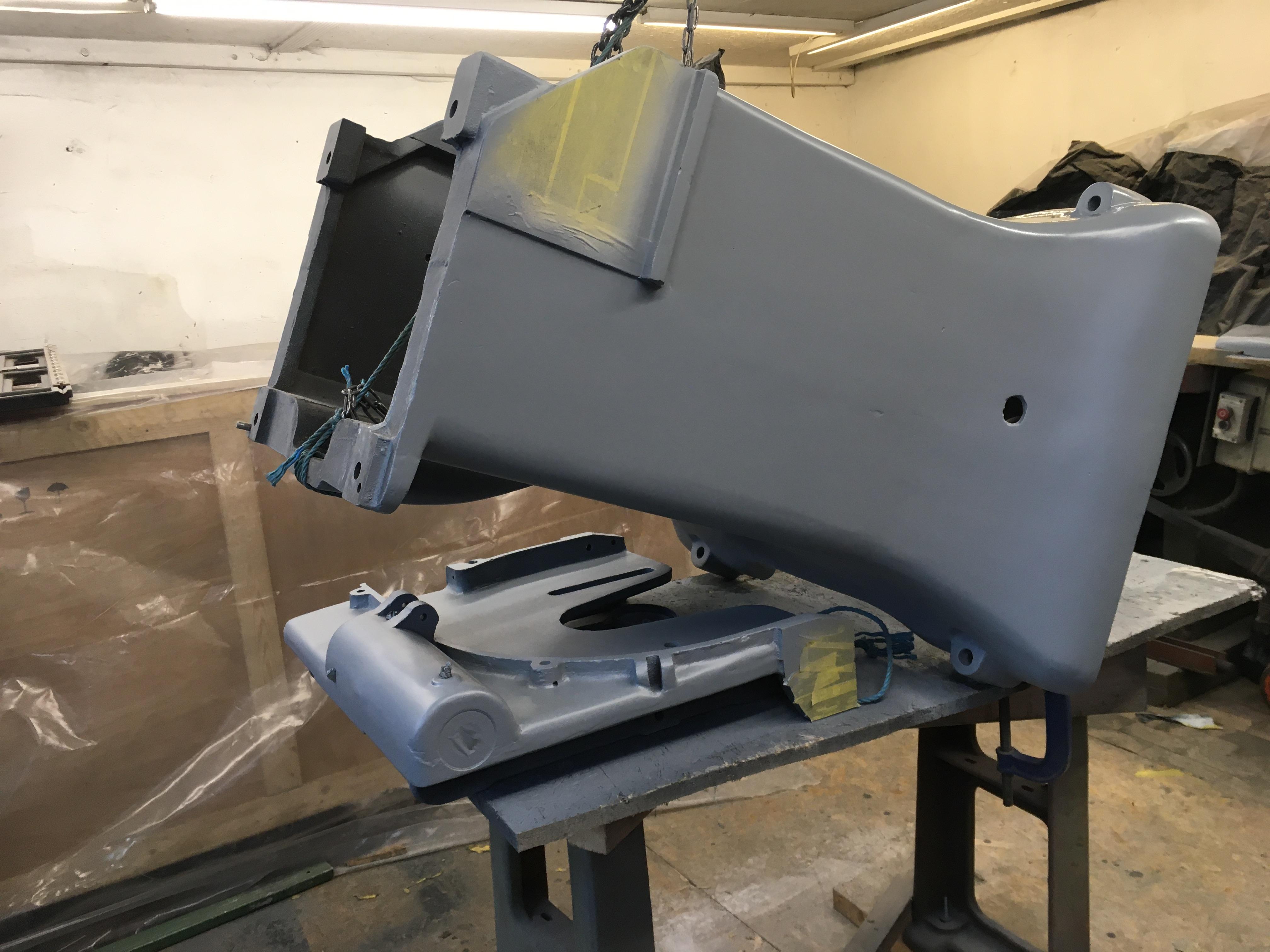
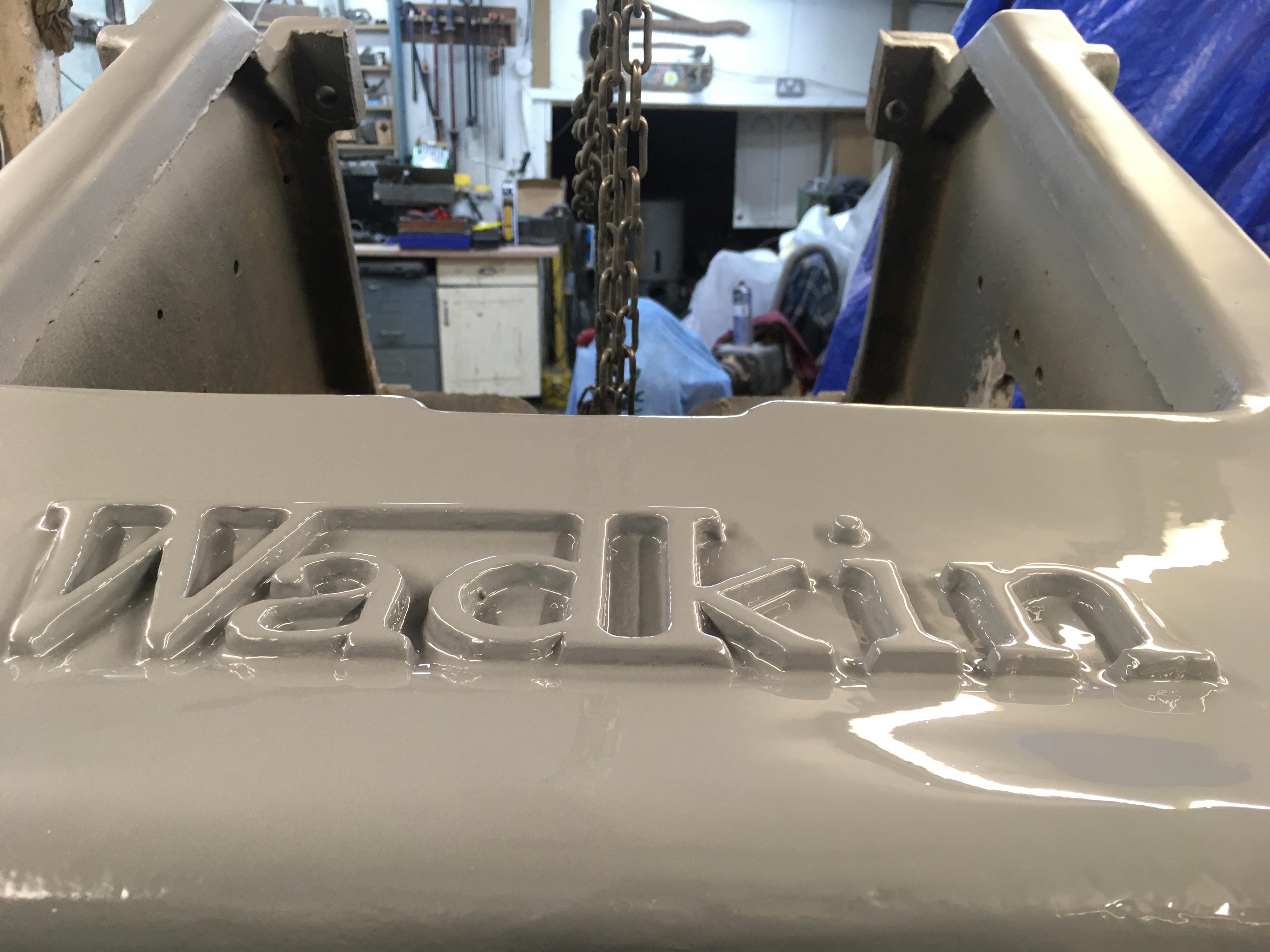
And then a big dollop of water drips from your mask
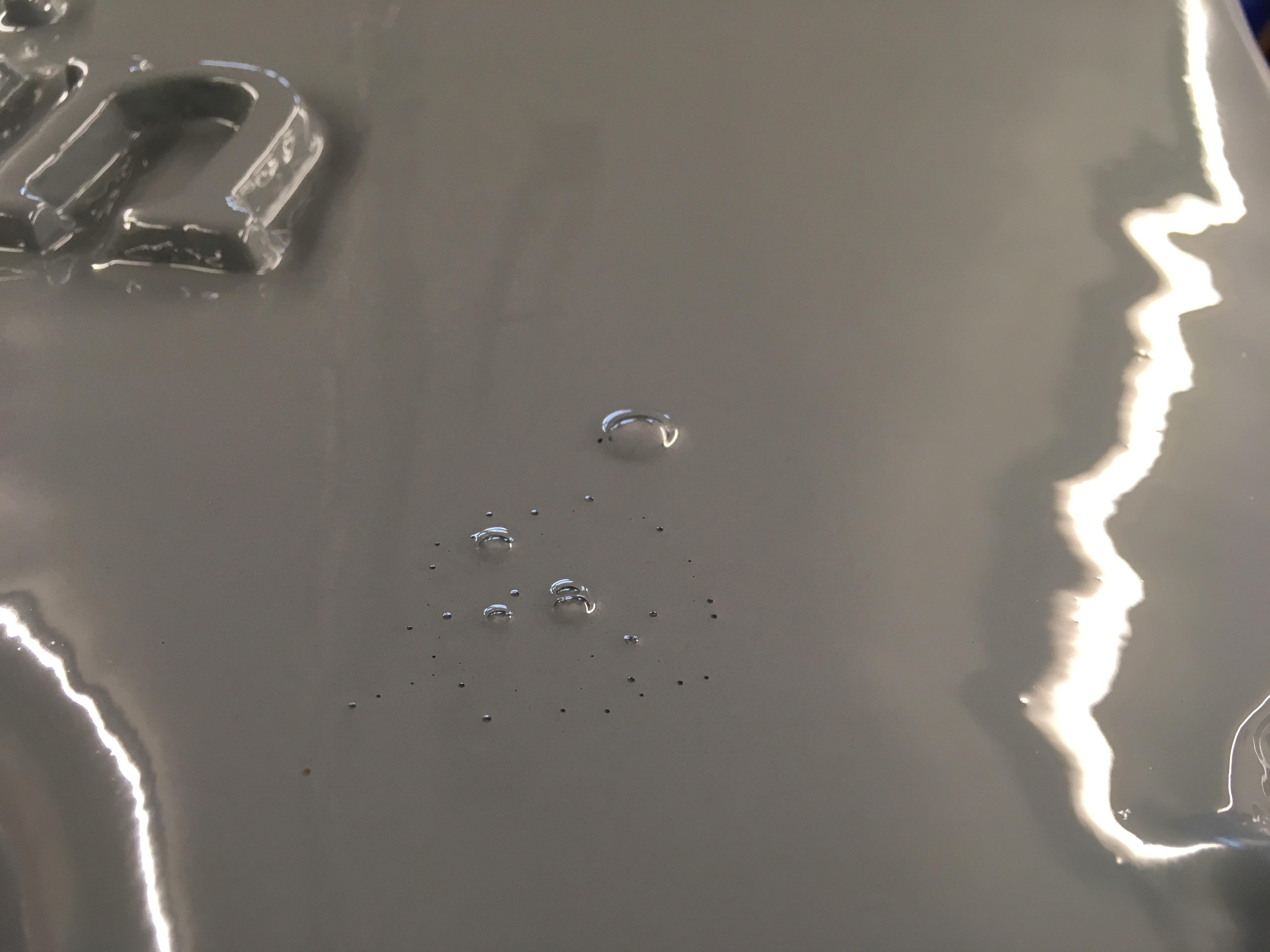
The day after, I did manage to rescue it, had to sand and fill it then sprayed again
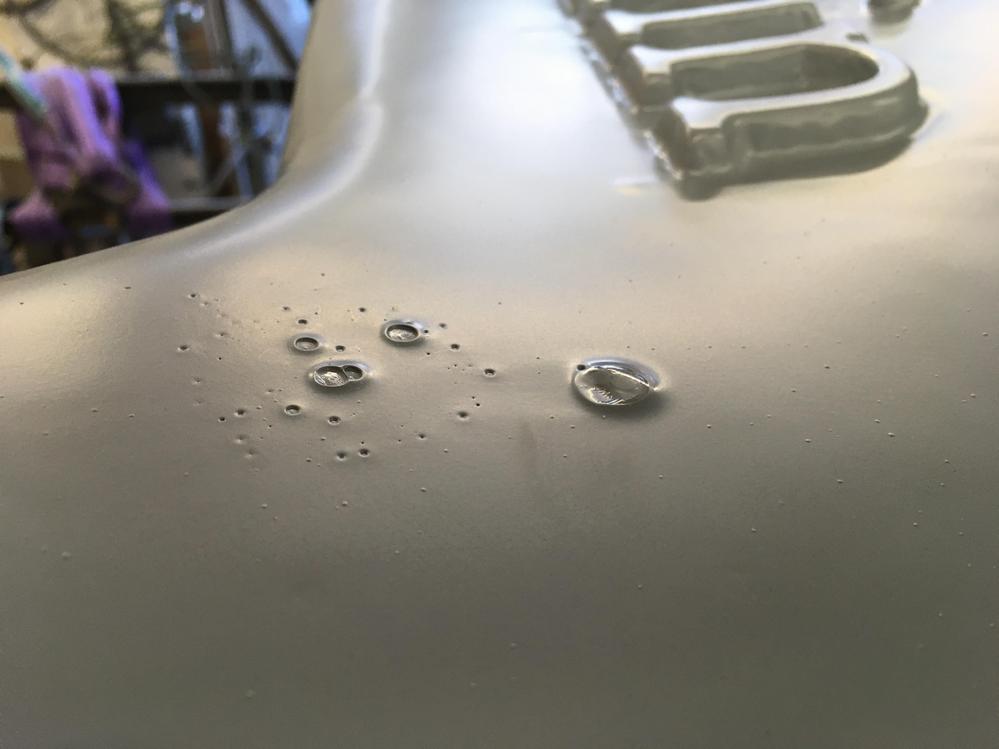
Top coat
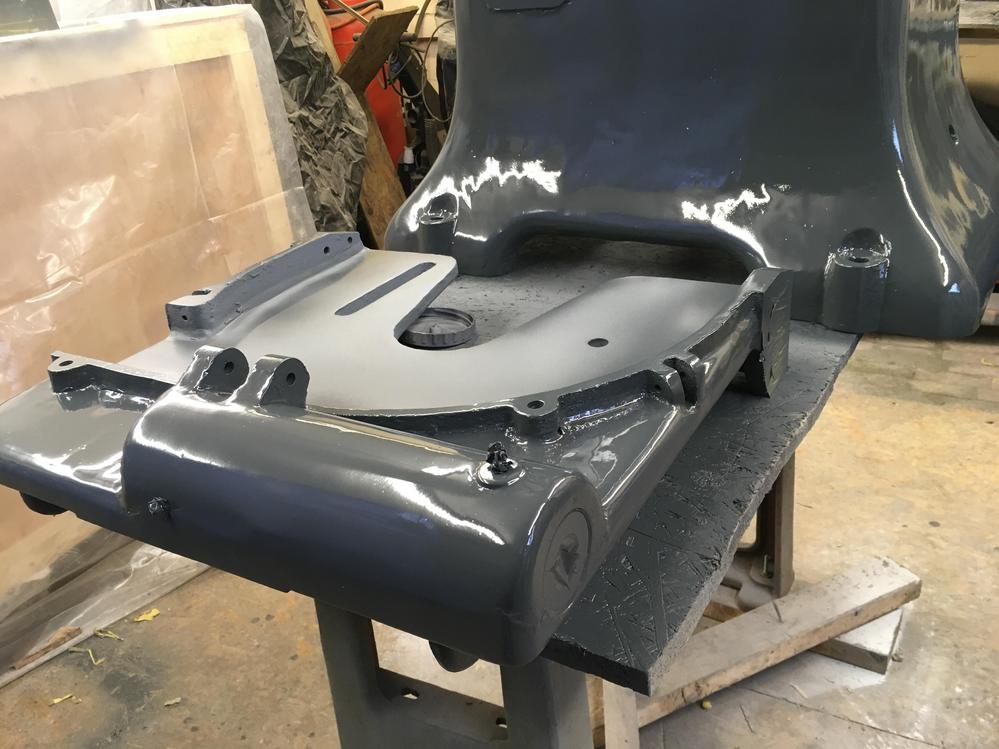
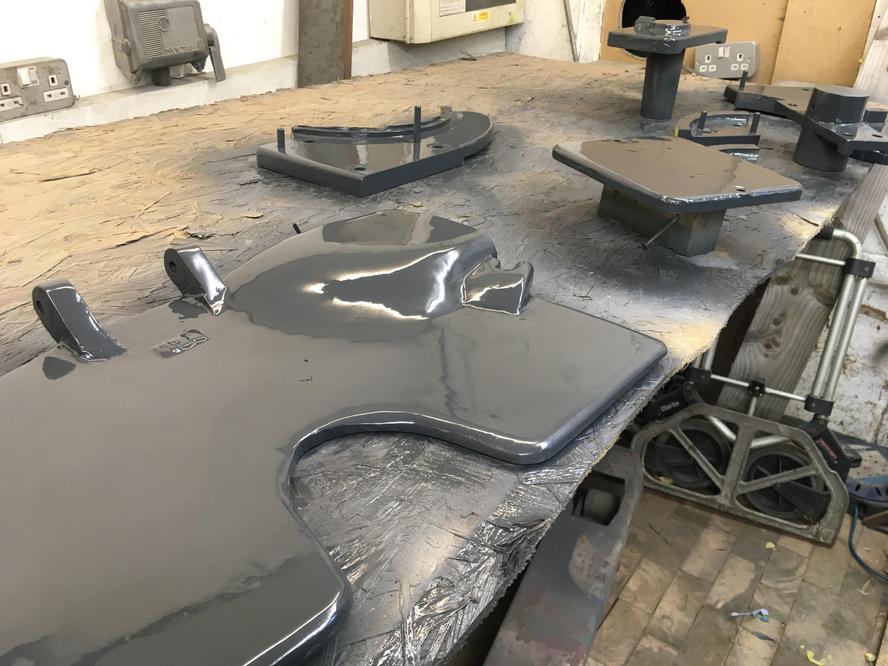
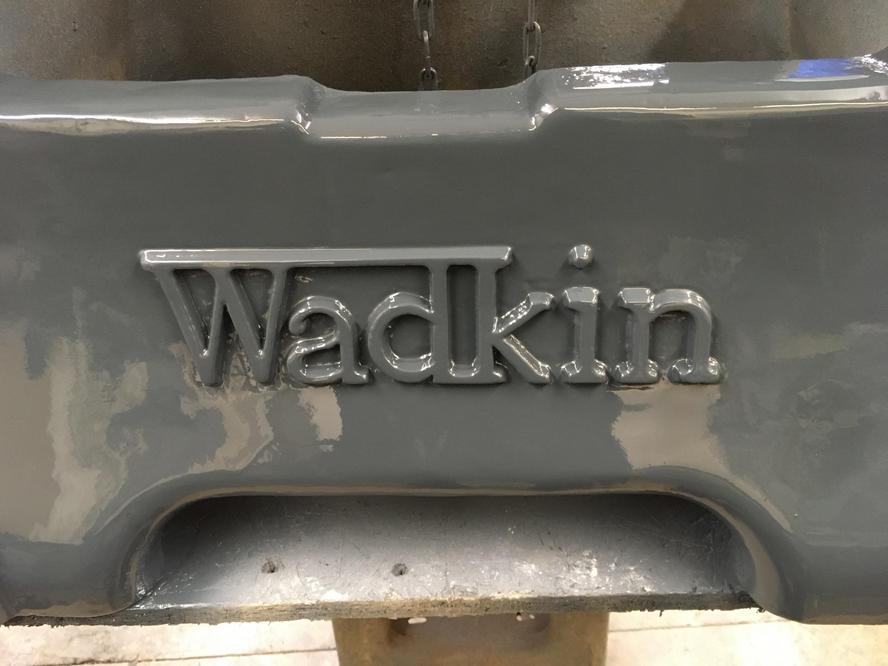
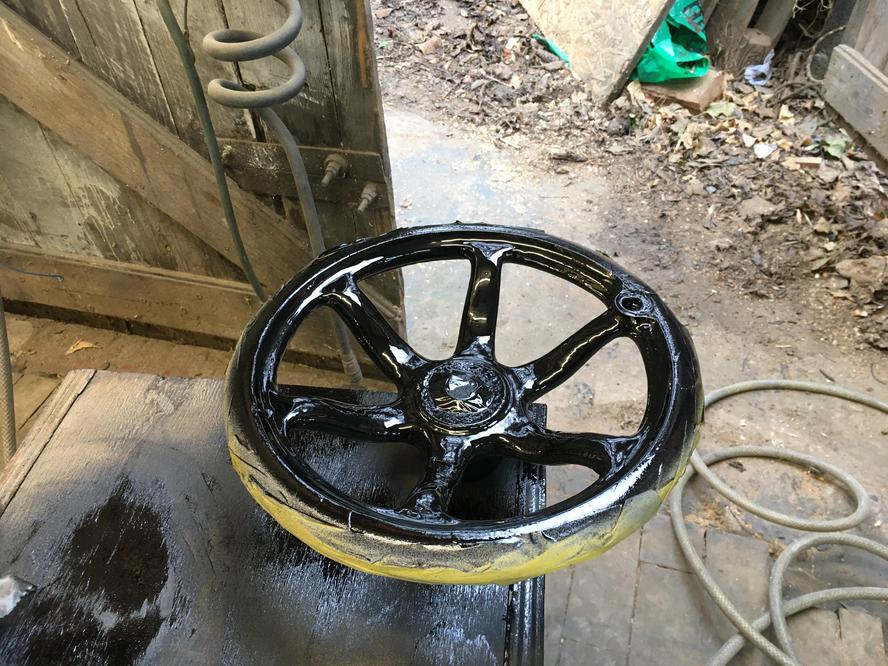
Whilst the filler was drying I started on the handles, In the lathe slow speed and used the grinder with a flapper disc then sandpaper from 120 to 800 followed by a buff with red silverline compound
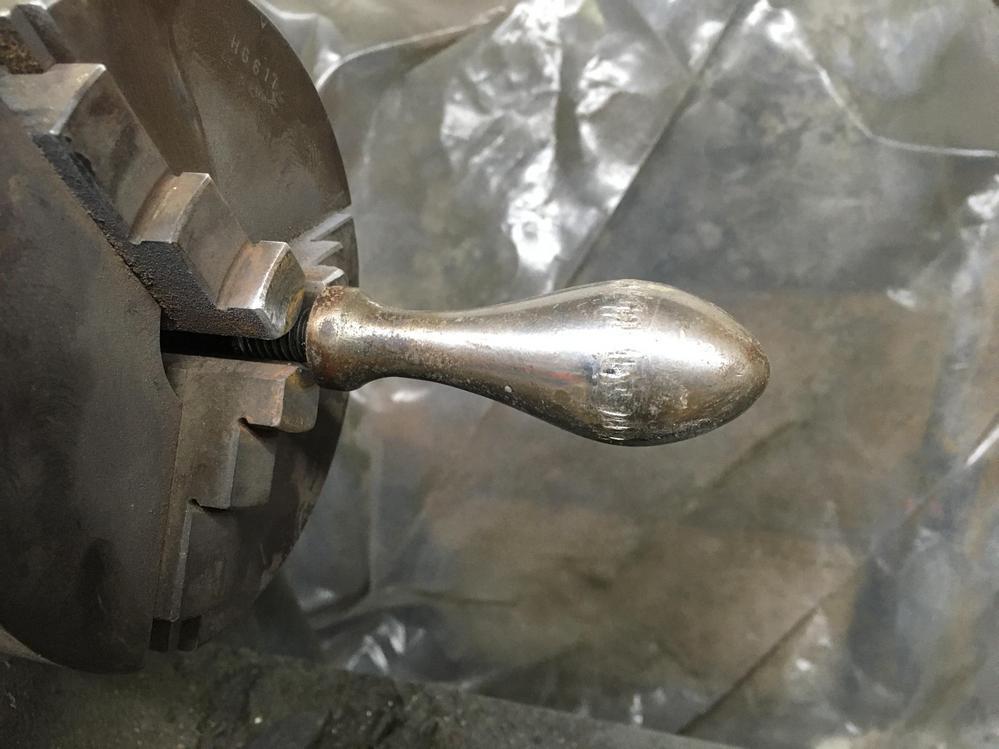
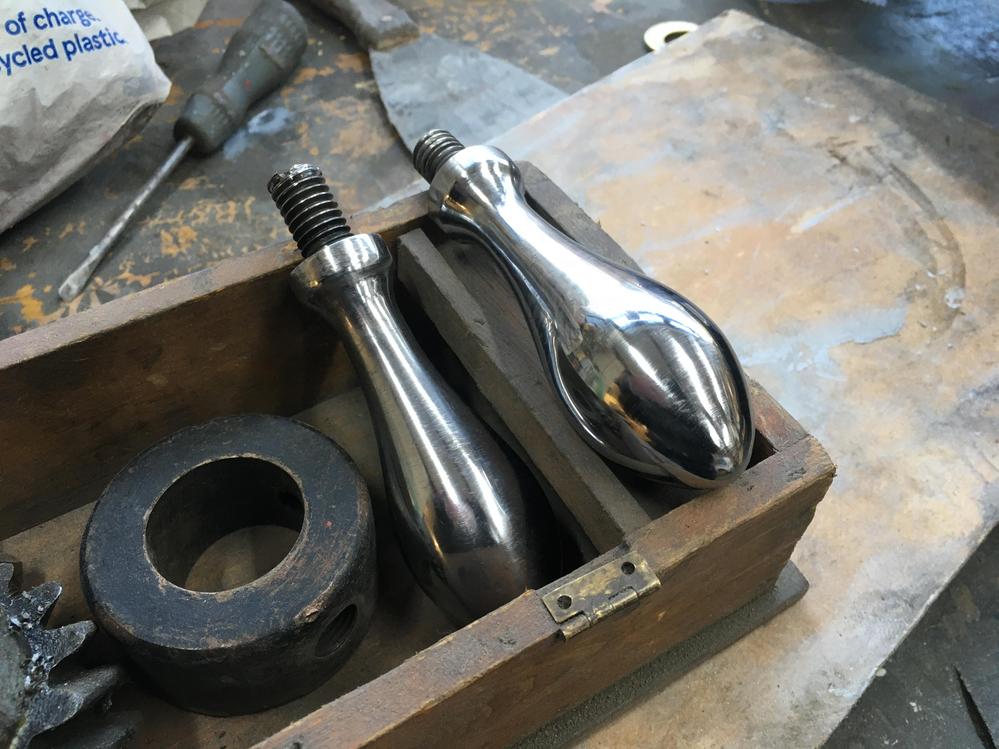


And then a big dollop of water drips from your mask

The day after, I did manage to rescue it, had to sand and fill it then sprayed again

Top coat




Whilst the filler was drying I started on the handles, In the lathe slow speed and used the grinder with a flapper disc then sandpaper from 120 to 800 followed by a buff with red silverline compound


KT_NorCal
Established Member
Hi Wallace, Do you spray multiple coats on the lettering or actually dollop it on?To get a good result with the writing its best to flood the area with primer, obviously you can get more paint on if its flat.

Works out nice, I still can't understand how you can get such a nice finish in the garage. Every time I spray anything something ends up in the paint (usually a tiny bug)...
Similar threads
- Replies
- 46
- Views
- 4K




























